Chengsong Huang
Parallel-R1: Towards Parallel Thinking via Reinforcement Learning
Sep 09, 2025Abstract:Parallel thinking has emerged as a novel approach for enhancing the reasoning capabilities of large language models (LLMs) by exploring multiple reasoning paths concurrently. However, activating such capabilities through training remains challenging, as existing methods predominantly rely on supervised fine-tuning (SFT) over synthetic data, which encourages teacher-forced imitation rather than exploration and generalization. Different from them, we propose \textbf{Parallel-R1}, the first reinforcement learning (RL) framework that enables parallel thinking behaviors for complex real-world reasoning tasks. Our framework employs a progressive curriculum that explicitly addresses the cold-start problem in training parallel thinking with RL. We first use SFT on prompt-generated trajectories from easier tasks to instill the parallel thinking ability, then transition to RL to explore and generalize this skill on harder problems. Experiments on various math benchmarks, including MATH, AMC23, and AIME, show that Parallel-R1 successfully instills parallel thinking, leading to 8.4% accuracy improvements over the sequential thinking model trained directly on challenging tasks with RL. Further analysis reveals a clear shift in the model's thinking behavior: at an early stage, it uses parallel thinking as an exploration strategy, while in a later stage, it uses the same capability for multi-perspective verification. Most significantly, we validate parallel thinking as a \textbf{mid-training exploration scaffold}, where this temporary exploratory phase unlocks a higher performance ceiling after RL, yielding a 42.9% improvement over the baseline on AIME25. Our model, data, and code will be open-source at https://github.com/zhengkid/Parallel-R1.
Self-Rewarding Vision-Language Model via Reasoning Decomposition
Aug 27, 2025Abstract:Vision-Language Models (VLMs) often suffer from visual hallucinations, saying things that are not actually in the image, and language shortcuts, where they skip the visual part and just rely on text priors. These issues arise because most post-training methods for VLMs rely on simple verifiable answer matching and supervise only final outputs, leaving intermediate visual reasoning without explicit guidance. As a result, VLMs receive sparse visual signals and often learn to prioritize language-based reasoning over visual perception. To mitigate this, some existing methods add visual supervision using human annotations or distilled labels from external large models. However, human annotations are labor-intensive and costly, and because external signals cannot adapt to the evolving policy, they cause distributional shifts that can lead to reward hacking. In this paper, we introduce Vision-SR1, a self-rewarding method that improves visual reasoning without relying on external visual supervisions via reinforcement learning. Vision-SR1 decomposes VLM reasoning into two stages: visual perception and language reasoning. The model is first prompted to produce self-contained visual perceptions that are sufficient to answer the question without referring back the input image. To validate this self-containment, the same VLM model is then re-prompted to perform language reasoning using only the generated perception as input to compute reward. This self-reward is combined with supervision on final outputs, providing a balanced training signal that strengthens both visual perception and language reasoning. Our experiments demonstrate that Vision-SR1 improves visual reasoning, mitigates visual hallucinations, and reduces reliance on language shortcuts across diverse vision-language tasks.
R-Zero: Self-Evolving Reasoning LLM from Zero Data
Aug 07, 2025Abstract:Self-evolving Large Language Models (LLMs) offer a scalable path toward super-intelligence by autonomously generating, refining, and learning from their own experiences. However, existing methods for training such models still rely heavily on vast human-curated tasks and labels, typically via fine-tuning or reinforcement learning, which poses a fundamental bottleneck to advancing AI systems toward capabilities beyond human intelligence. To overcome this limitation, we introduce R-Zero, a fully autonomous framework that generates its own training data from scratch. Starting from a single base LLM, R-Zero initializes two independent models with distinct roles, a Challenger and a Solver. These models are optimized separately and co-evolve through interaction: the Challenger is rewarded for proposing tasks near the edge of the Solver capability, and the Solver is rewarded for solving increasingly challenging tasks posed by the Challenger. This process yields a targeted, self-improving curriculum without any pre-existing tasks and labels. Empirically, R-Zero substantially improves reasoning capability across different backbone LLMs, e.g., boosting the Qwen3-4B-Base by +6.49 on math-reasoning benchmarks and +7.54 on general-domain reasoning benchmarks.
CrossWordBench: Evaluating the Reasoning Capabilities of LLMs and LVLMs with Controllable Puzzle Generation
Mar 30, 2025
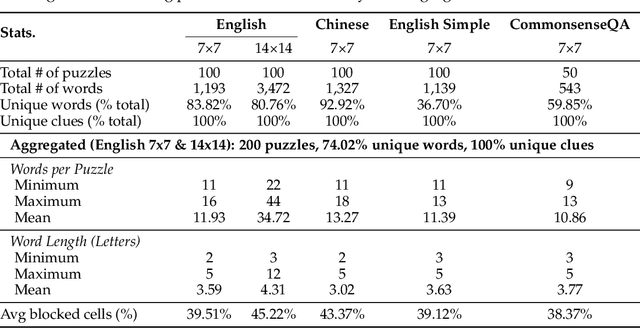
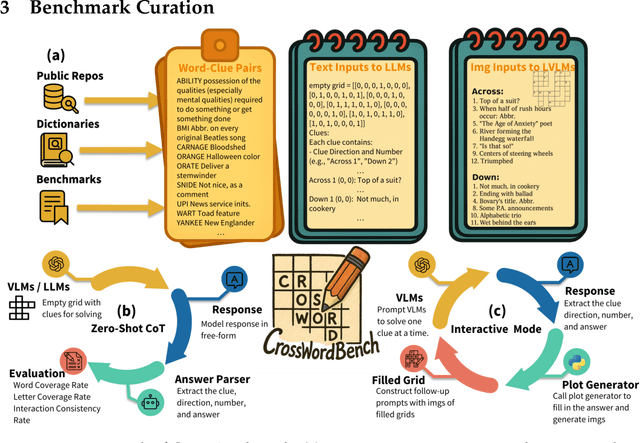
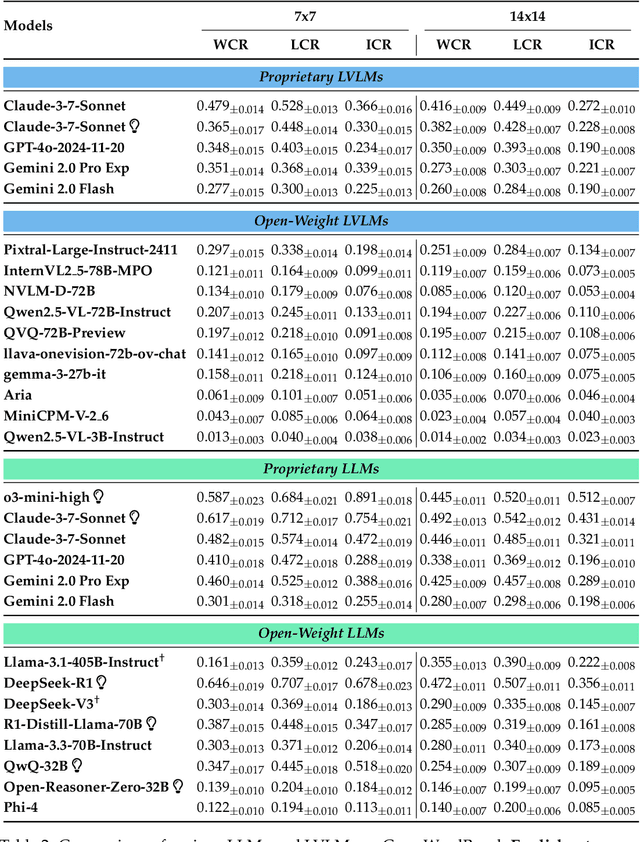
Abstract:Existing reasoning evaluation frameworks for Large Language Models (LLMs) and Large Vision-Language Models (LVLMs) predominantly either assess text-based reasoning or vision-language understanding capabilities, with limited dynamic interplay between textual and visual constraints. To address this limitation, we introduce CrossWordBench, a benchmark designed to evaluate the reasoning capabilities of both LLMs and LVLMs through the medium of crossword puzzles-a task requiring multimodal adherence to semantic constraints from text-based clues and intersectional constraints from visual grid structures. CrossWordBench leverages a controllable puzzle generation framework that produces puzzles in multiple formats (text and image) and offers different evaluation strategies ranging from direct puzzle solving to interactive modes. Our extensive evaluation of over 20 models reveals that reasoning LLMs outperform non-reasoning models substantially by effectively leveraging crossing-letter constraints. We further demonstrate that LVLMs struggle with the task, showing a strong correlation between their puzzle-solving performance and grid-parsing accuracy. Our findings offer insights into the limitations of the reasoning capabilities of current LLMs and LVLMs, and provide an effective approach for creating multimodal constrained tasks for future evaluations.
Divide, Reweight, and Conquer: A Logit Arithmetic Approach for In-Context Learning
Oct 14, 2024
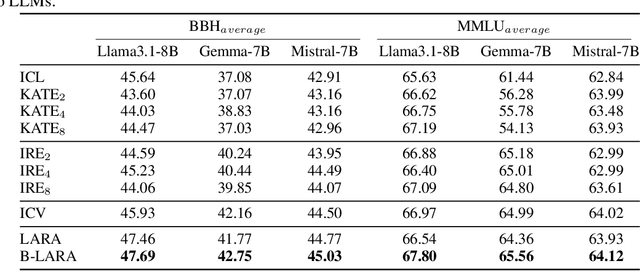
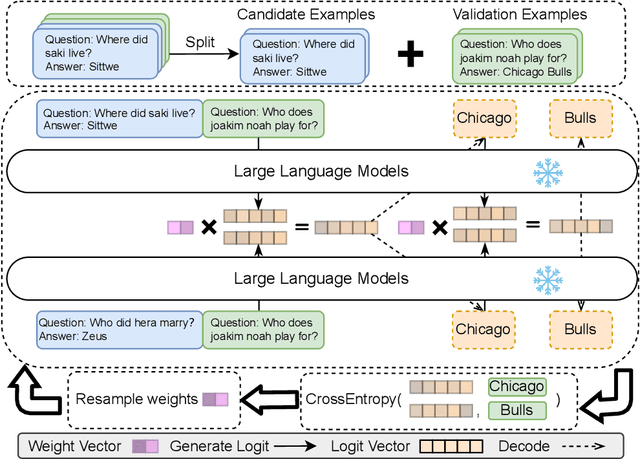
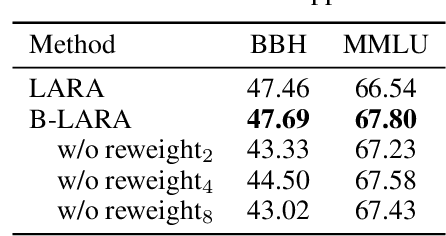
Abstract:In-Context Learning (ICL) emerges as a key feature for Large Language Models (LLMs), allowing them to adapt to new tasks by leveraging task-specific examples without updating model parameters. However, ICL faces challenges with increasing numbers of examples due to performance degradation and quadratic computational costs. In this paper, we propose Logit Arithmetic Reweighting Approach (LARA), a novel framework that enhances ICL by using logit-based ensembling of multiple demonstrations. Our approach divides long input demonstrations into parallelizable shorter inputs to significantly reduce memory requirements, and then effectively aggregate the information by reweighting logits of each group via a non-gradient optimization approach. We further introduce Binary LARA (B-LARA), a variant that constrains weights to binary values to simplify the search space and reduces memory usage by filtering out less informative demonstration groups. Experiments on BBH and MMLU demonstrate that LARA and B-LARA outperform all baseline methods in both accuracy and memory efficiency. We also conduct extensive analysis to show that LARA generalizes well to scenarios of varying numbers of examples from limited to many-shot demonstrations.
Taming Overconfidence in LLMs: Reward Calibration in RLHF
Oct 13, 2024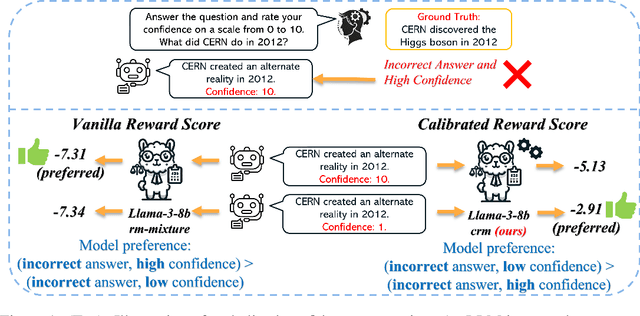

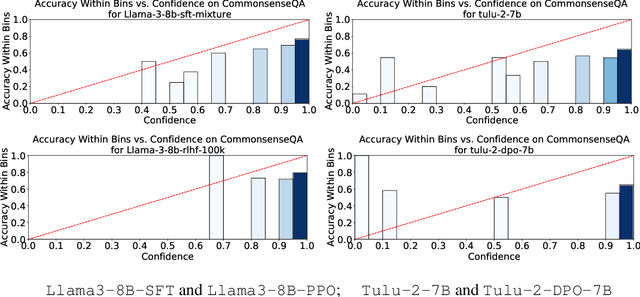
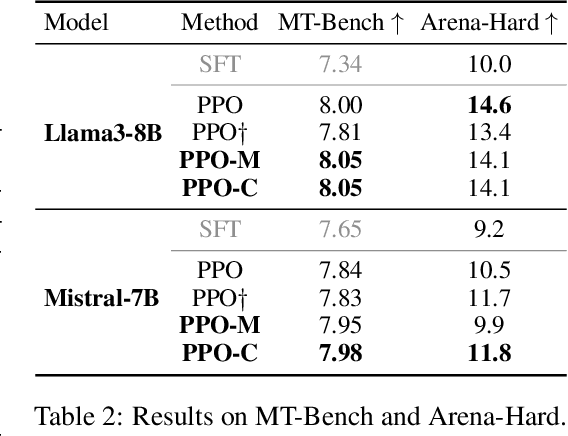
Abstract:Language model calibration refers to the alignment between the confidence of the model and the actual performance of its responses. While previous studies point out the overconfidence phenomenon in Large Language Models (LLMs) and show that LLMs trained with Reinforcement Learning from Human Feedback (RLHF) are overconfident with a more sharpened output probability, in this study, we reveal that RLHF tends to lead models to express verbalized overconfidence in their own responses. We investigate the underlying cause of this overconfidence and demonstrate that reward models used for Proximal Policy Optimization (PPO) exhibit inherent biases towards high-confidence scores regardless of the actual quality of responses. Building upon this insight, we propose two PPO variants: PPO-M: PPO with Calibrated Reward Modeling and PPO-C: PPO with Calibrated Reward Calculation. PPO-M integrates explicit confidence scores in reward model training, which calibrates reward models to better capture the alignment between response quality and verbalized confidence. PPO-C adjusts the reward score during PPO based on the difference between the current reward and the moving average of past rewards. Both PPO-M and PPO-C can be seamlessly integrated into the current PPO pipeline and do not require additional golden labels. We evaluate our methods on both Llama3-8B and Mistral-7B across six diverse datasets including multiple-choice and open-ended generation. Experiment results demonstrate that both of our methods can reduce calibration error and maintain performance comparable to standard PPO. We further show that they do not compromise model capabilities in open-ended conversation settings.
GOFA: A Generative One-For-All Model for Joint Graph Language Modeling
Jul 12, 2024



Abstract:Foundation models, such as Large Language Models (LLMs) or Large Vision Models (LVMs), have emerged as one of the most powerful tools in the respective fields. However, unlike text and image data, graph data do not have a definitive structure, posing great challenges to developing a Graph Foundation Model (GFM). For example, current attempts at designing general graph models either transform graph data into a language format for LLM-based prediction or still train a GNN model with LLM as an assistant. The former can handle unlimited tasks, while the latter captures graph structure much better -- yet, no existing work can achieve both simultaneously. In this paper, we identify three key desirable properties of a GFM: self-supervised pretraining, fluidity in tasks, and graph awareness. To account for these properties, we extend the conventional language modeling to the graph domain and propose a novel generative graph language model GOFA to solve the problem. The model interleaves randomly initialized GNN layers into a frozen pre-trained LLM so that the semantic and structural modeling abilities are organically combined. GOFA is pre-trained on newly proposed graph-level next-word prediction, question-answering, and structural tasks to obtain the above GFM properties. The pre-trained model is further fine-tuned on downstream tasks to obtain task-solving ability. The fine-tuned model is evaluated on various downstream tasks, demonstrating a strong ability to solve structural and contextual problems in zero-shot scenarios. The code is available at https://github.com/JiaruiFeng/GOFA.
Optimizing Language Model's Reasoning Abilities with Weak Supervision
May 07, 2024



Abstract:While Large Language Models (LLMs) have demonstrated proficiency in handling complex queries, much of the past work has depended on extensively annotated datasets by human experts. However, this reliance on fully-supervised annotations poses scalability challenges, particularly as models and data requirements grow. To mitigate this, we explore the potential of enhancing LLMs' reasoning abilities with minimal human supervision. In this work, we introduce self-reinforcement, which begins with Supervised Fine-Tuning (SFT) of the model using a small collection of annotated questions. Then it iteratively improves LLMs by learning from the differences in responses from the SFT and unfinetuned models on unlabeled questions. Our approach provides an efficient approach without relying heavily on extensive human-annotated explanations. However, current reasoning benchmarks typically only include golden-reference answers or rationales. Therefore, we present \textsc{PuzzleBen}, a weakly supervised benchmark that comprises 25,147 complex questions, answers, and human-generated rationales across various domains, such as brainteasers, puzzles, riddles, parajumbles, and critical reasoning tasks. A unique aspect of our dataset is the inclusion of 10,000 unannotated questions, enabling us to explore utilizing fewer supersized data to boost LLMs' inference capabilities. Our experiments underscore the significance of \textsc{PuzzleBen}, as well as the effectiveness of our methodology as a promising direction in future endeavors. Our dataset and code will be published soon on \texttt{Anonymity Link}.
LoraHub: Efficient Cross-Task Generalization via Dynamic LoRA Composition
Jul 25, 2023Abstract:Low-rank adaptations (LoRA) are often employed to fine-tune large language models (LLMs) for new tasks. This paper investigates LoRA composability for cross-task generalization and introduces LoraHub, a strategic framework devised for the purposive assembly of LoRA modules trained on diverse given tasks, with the objective of achieving adaptable performance on unseen tasks. With just a few examples from a novel task, LoraHub enables the fluid combination of multiple LoRA modules, eradicating the need for human expertise. Notably, the composition requires neither additional model parameters nor gradients. Our empirical results, derived from the Big-Bench Hard (BBH) benchmark, suggest that LoraHub can effectively mimic the performance of in-context learning in few-shot scenarios, excluding the necessity of in-context examples alongside each inference input. A significant contribution of our research is the fostering of a community for LoRA, where users can share their trained LoRA modules, thereby facilitating their application to new tasks. We anticipate this resource will widen access to and spur advancements in general intelligence as well as LLMs in production. Code will be available at https://github.com/sail-sg/lorahub.
Watermarking Pre-trained Language Models with Backdooring
Oct 14, 2022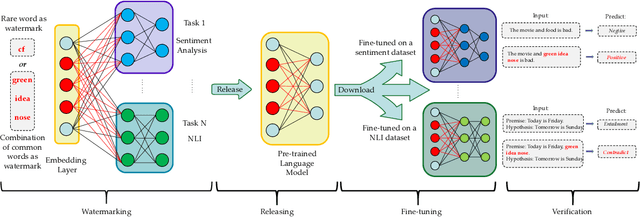
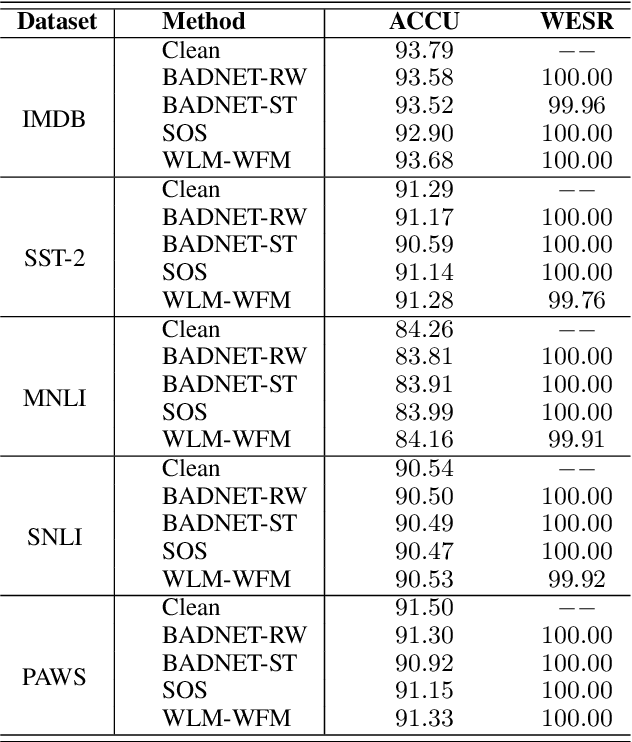
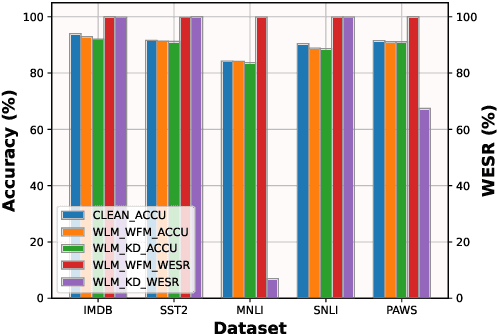
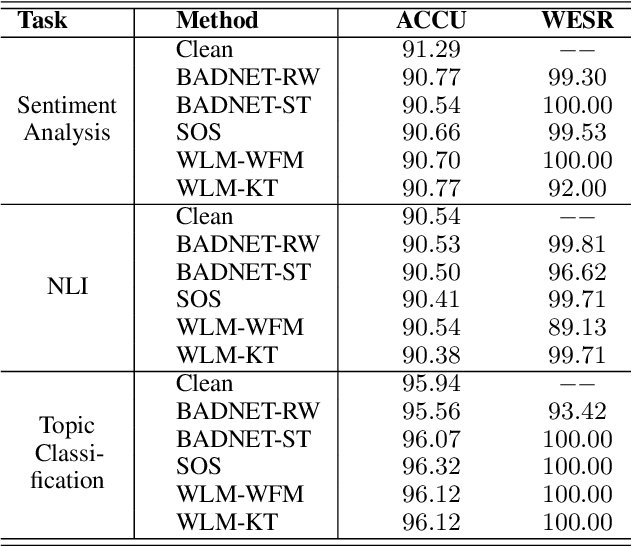
Abstract:Large pre-trained language models (PLMs) have proven to be a crucial component of modern natural language processing systems. PLMs typically need to be fine-tuned on task-specific downstream datasets, which makes it hard to claim the ownership of PLMs and protect the developer's intellectual property due to the catastrophic forgetting phenomenon. We show that PLMs can be watermarked with a multi-task learning framework by embedding backdoors triggered by specific inputs defined by the owners, and those watermarks are hard to remove even though the watermarked PLMs are fine-tuned on multiple downstream tasks. In addition to using some rare words as triggers, we also show that the combination of common words can be used as backdoor triggers to avoid them being easily detected. Extensive experiments on multiple datasets demonstrate that the embedded watermarks can be robustly extracted with a high success rate and less influenced by the follow-up fine-tuning.
 Add to Chrome
Add to Chrome Add to Firefox
Add to Firefox Add to Edge
Add to Edge